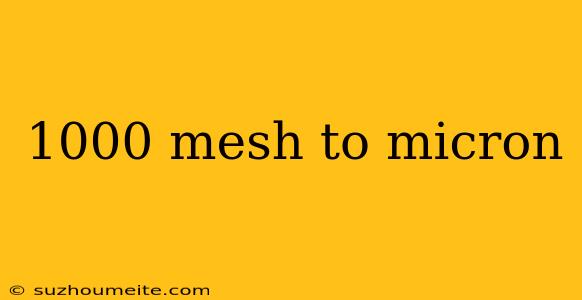Mesh to Micron Conversion: Understanding the Difference
When working with particles or materials of varying sizes, it's essential to understand the different units of measurement used to describe their dimensions. Two common units of measurement are mesh and micron, which are often used interchangeably but have distinct differences.
What is Mesh?
Mesh is a unit of measurement that refers to the number of openings per linear inch in a sieve or screen. It is used to describe the size of particles or materials that can pass through the sieve or screen. The mesh size is typically denoted by a number, which indicates the number of openings per inch. For example, a 1000 mesh screen has 1000 openings per linear inch.
What is Micron?
A micron is a unit of length in the metric system, equal to one millionth of a meter (μm). It is commonly used to measure the size of particles, cells, and other small objects. Microns are often used in scientific and industrial applications, such as in the measurement of particle size, filter pore size, and material thickness.
Converting Mesh to Micron
To convert mesh to micron, we need to understand the relationship between the two units. A higher mesh size indicates smaller openings, which means smaller particles can pass through. Conversely, a larger micron size indicates larger particles.
The following table provides a general guideline for converting mesh to micron:
| Mesh | Micron |
|---|---|
| 1000 | 15-20 μm |
| 500 | 30-40 μm |
| 200 | 70-80 μm |
| 100 | 140-160 μm |
As you can see, a 1000 mesh screen corresponds to a particle size of around 15-20 microns. This means that particles larger than 15-20 microns cannot pass through a 1000 mesh screen.
Importance of Accurate Conversion
Accurate conversion between mesh and micron is crucial in various industries, such as:
- Food and Beverage: Particle size affects the texture, taste, and appearance of food products.
- Pharmaceuticals: Particle size can impact the efficacy and safety of medications.
- Materials Science: Particle size affects the properties and behavior of materials.
Inaccurate conversion can lead to errors in production, processing, and quality control, resulting in costly mistakes and even safety risks.
Conclusion
In conclusion, mesh and micron are two distinct units of measurement used to describe particle size. Understanding the conversion between mesh and micron is essential in various industries to ensure accurate production, processing, and quality control. By using the conversion guidelines provided above, you can ensure that your measurements are accurate and reliable.
